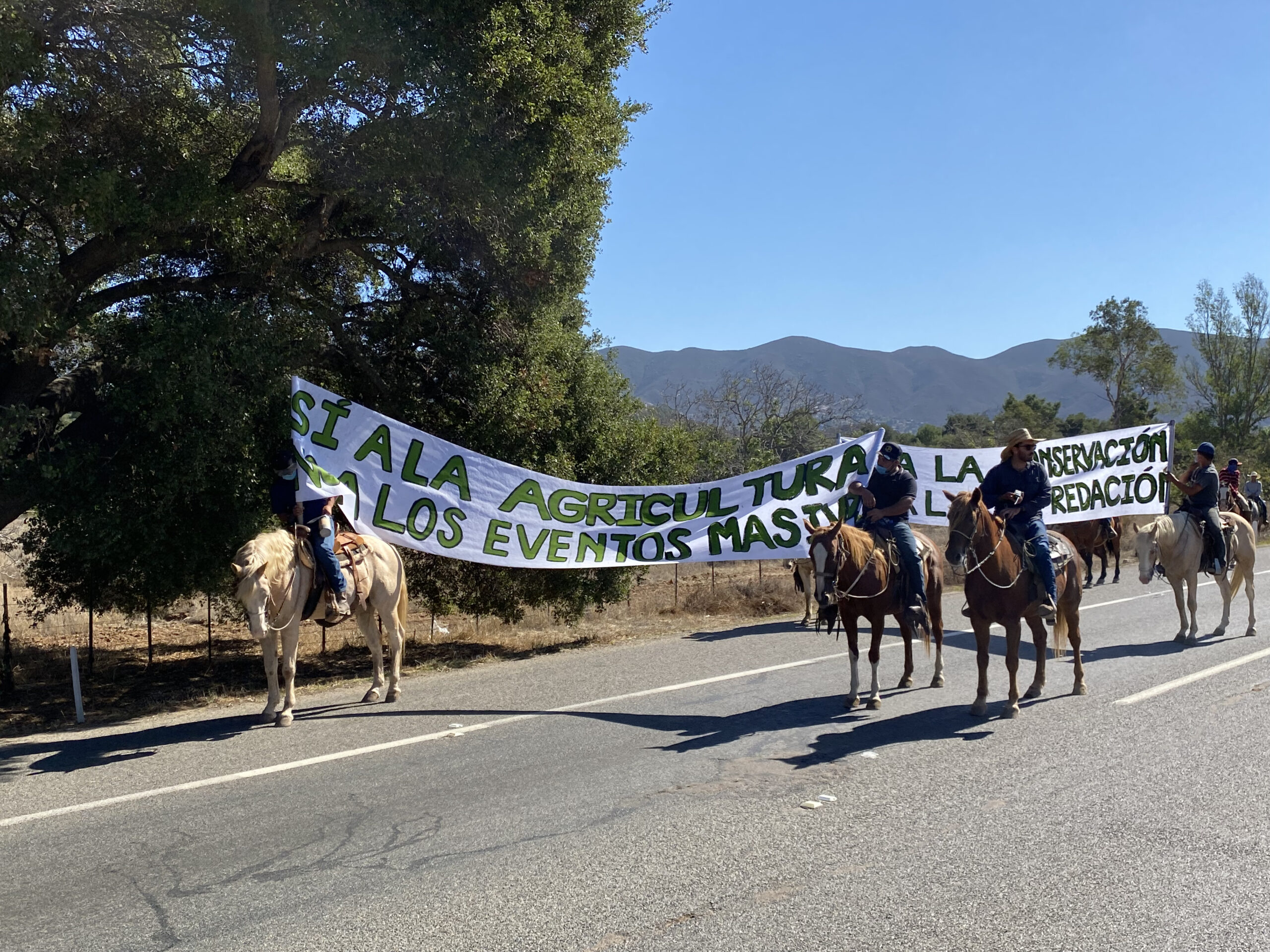[dropcap size=big]M[/dropcap]ore than 300 winemakers, hospitality workers, and residents of Valle de Guadalupe successfully marched through Mexican wine country on Saturday afternoon in a peaceful protest opposing the construction of a 62-acre temporary music venue that would hold up to 25,000 people. The following day, a concert was set to take place but ultimately moved to another location due to the community’s pushback.
The passionate supporters behind the “Por Un Valle de Verdad” campaign argue that Valle’s extremely delicate ecosystem and scarce resources like its water supply cannot afford such a large-scale development and the volume of people it would bring at a time.
Mexican wine country, located about a 3 1/2 hour drive from Los Angeles, is a popular tourist destination for San Diego, Orange County, and Los Angeles residents who drive there to dine, drink, and stay in its luxury boutique hotels in a picturesque and laidback landscape. An inquiry with leaders in the Mexican wine community from L.A. TACO reveals that almost half of the tourism into Valle de Guadalupe is from California—at 40 percent of its core tourism.
Notable L.A. chefs like Nancy Silverton, Ricardo Zarate, and Tim Hollingsworth have been known to cook out there on occasion. While it is a relatively young wine industry at barely a century old, there are more than 150 working wineries in the area.
Protestors on Saturday rode horses and held street-wide banners on Valle’s main two-lane road that read “Si a La Agricultura, No a Los Eventos Masivos.” Javier Plascencia, Baja’s California’s most prolific chef, is one of the campaign’s biggest supporters. He was one of the first chefs to open in Valle with his outdoor restaurant, Finca Altozano, in 2012. Aside from being one of the early adopters, Plascencia has also taken a DIY approach to fundraise and gather supplies for Valle de Guadalupe’s first responders. At times, relying on used firefighter gear from neighboring San Diego. Valle de Guadalupe does not have an official Fire Station and instead relies on community volunteers who do not have any national, state, or local funding.
Valle de Guadalupe currently has a population of 9000 people and lies in the municipality of Ensenada, the larger port city in the area, which is about 30 minutes away driving.
“The problem with this new development isn’t the artist or the type of music. It’s the reality that we don’t have enough resources or infrastructure to support the issues that may arise from it,” Plascencia tells L.A. TACO. “We don’t have enough ambulances, fire, or police to provide services to the drunk driving-based accidents and fights that go hand in and with these concerts.” According to Plascencia, the future of Valle de Guadalupe and what is allowed to be built there should be decided by the winemakers and chefs who have worked hard to make Valle the destination it has become. “This is a space that we need to take care of—its wines, its beautiful sunsets, its unique gastronomy. We don’t want it to turn into a large-scale cantina. We can still stop it from becoming that.”
While Valle is home to large old-world wineries like L.A. Cetto and Monte Xanic that supply restaurants and big-box retailers to all of Mexico, it is also the home to a tiny but mighty booming natural wine industry. Andres Labadie, an Ensenada native who works in hospitality and recently started his Wine Nomada natural wine label, tells L.A. TACO that the fight to protect Mexican wine country is a fight to preserve nature.
While the 62 acres of land have already been demolished, the successful protestors behind “Un Valle de Verdad” have hopefully set a precedent for the future of nature tourism in Mexico. One in which the workers of the land manage the respective regions and not politicians that are prone to corruption and bribes.
“Whether you are a Mexican or American tourist doesn’t matter. What matters is protecting the natural environment from contamination and conserving the precious water supply here—this should matter to everyone.”
Mexico has a history of exploiting nature-based tourist attractions at both a local and political level. Oaxaca’s petrified waterfalls Hierve El Agua closed earlier this year to the contamination brought on by an uncontrolled amount of tourists, along with a political dispute between the two villages regarding the earnings of its admission cost. Southern Mexico’s stunningly beautiful “Seven Water Lagoon” known as Bacalar started to lose its colors and develop a stronger putrid off smell due to contamination. Drugs in the water and man-made toxic sargassum seaweed continue to plague Tulum and cost them millions of dollars in lost tourism and clean-up efforts.
However, there have also been success stories in Mexico. One of Mexico’s most beautiful beaches, Balandra in La Paz, successfully maintained control and limited the damage caused by visitors during recent spikes in tourism.
While the 62 acres of fertile land have already been demolished, the successful protestors behind “Un Valle de Verdad” have hopefully set a precedent for the future of nature tourism in Mexico. One in which the workers of the land manage the respective regions and not politicians that are prone to corruption and bribes. There are rumors of other significant developments on the horizon, such as casinos and shopping centers. Still, they will all have to answer to the organized community of Valle de Guadalupe first.
Sheyla Alvarado, the chef behind the winery and restaurant Lunario Restaurante, summed it up best to L.A. TACO.
“The responsible growth of Valle de Guadalupe and commitment to maintaining its agricultural identity is the responsibility of its residents, workers, and tourists—alike.”
The interviews were conducted in Spanish and translated to English by the author.







